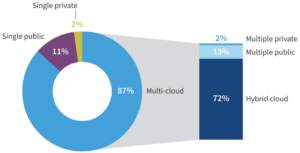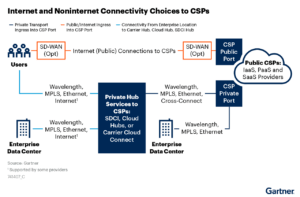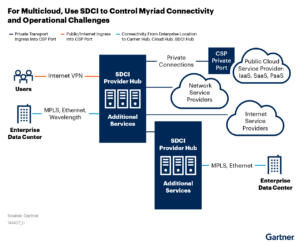In today’s rapidly evolving digital landscape, businesses are increasingly adopting multicloud strategies, harnessing the power of multiple cloud service providers to drive innovation and digital transformation. According to the Flexera 2023 State of the Cloud Report which surveyed 750 global cloud decision-makers and users, 87% of respondents reported having a multicloud strategy. Multicloud has become the de facto standard for enterprise cloud usage, with a super majority of organizations using two or more clouds, and 72% of multicloud users also operating in a hybrid cloud environment, including one or more private clouds in their multicloud landscape.

N=750
Source: Flexera 2023 State of the Cloud Report
As enterprises tap into multicloud, they are deploying workloads in myriad ways including:
- Applications siloed on different clouds
- Disaster recovery and failover between clouds
- Data storage and integration across public and private clouds
- Applications with workload mobility across public clouds
- Individual applications spanning public and private cloud
- Cloud bursting from private to public cloud
Regardless of how the enterprise multicloud strategy evolves, one thing is certain, the increased use of multiple clouds and the expanding use cases makes managing networking a daunting task, requiring careful planning, implementation, and ongoing maintenance. In this blog post, we will delve into the intricacies of multi-cloud networking, exploring best practices and strategies to successfully navigate this complex terrain using a software-defined approach.
To begin, it’s crucial to understand some of the fundamental concepts of multi-cloud networking along with the range of multi cloud connectivity options. Gartner published a research report, How to Optimize Network Connectivity Into Public Cloud Providers, in which they cover a range of Internet and Non-Internet network connectivity options, outlined in Figure 1 below.
Figure 1.
 Source: Gartner: How to Optimize Network Connectivity Into Public Cloud Providers
Source: Gartner: How to Optimize Network Connectivity Into Public Cloud Providers
With the range of multi cloud networking services that exists across these domains, taming multi cloud connectivity is a challenge in itself. Other challenges include:
- Each cloud service provider (CSP) has their own ‘network constructs’ which is their way of doing networking on their platform. It’s like each CSP speaks their own language and there’s no focus on interpreting the language of other clouds, as they’d rather keep you inside their cloud.
- Security and compliance are major challenges as you run applications across multiple clouds. Gaining insight and visibility into what’s happening to your applications on networks in other clouds is a significant challenge.
- In the cloud world, network capacity, connection topology, and bandwidth demand can be highly variable, requiring a more agile way to manage logical networks on demand, including providing auto-scaling, virtualization, and resiliency.
To solve these challenges, you need a universal translator that not only speaks all of the CSP native networking languages, but also has the visibility to see across clouds, can service chain the appropriate security services when and as needed, and has the agility necessary to keep up with a constantly evolving environment.
Within the multicloud networking realm, there is an emerging solution, which Gartner refers to as Software Defined Cloud Interconnection (SDCI, see Figure 2). SDCI includes a number of multi cloud networking services that begin to solve some of the challenges above. SDCI vendors offer standalone multi cloud connectivity services, but an enterprise can also deploy an SDCI framework as an extension of an SD-WAN overlay.
Figure 2.
 Source: Gartner: How to Optimize Network Connectivity Into Public Cloud Providers
Source: Gartner: How to Optimize Network Connectivity Into Public Cloud Providers
The key is integrating Figures 1 and 2 above. One way to do this is to deploy your SD-WAN environment at the cloud edge in addition to the enterprise edge. Some enterprises are leveraging colocation vendors such as Equinix, Digital Realty, TierPoint, and Cyxtera among dozens of others globally to enable this. Identify the appropriate colocation facilities in your geographies that can provide direct cloud on-ramps, secure colocation space, deploy your SD-WAN breakout, and use it to directly connect to the CSP platforms.
This leads to a more integrated SDCI platform than simply extending an MPLS or Ethernet Private Line (EPL) from your datacenter to an SDCI provider. Under this architecture any SD-WAN endpoint can interconnect with any CSP platform, regardless of whether the SD-WAN endpoint is transported over a performant MPLS or EPL connection, or over the public internet.
It also provides improved visibility, and the ability to service chain premises or cloud-based security services, all controlled and routed by the SD-WAN policies.
Alternatively, find a vendor that will simplify all of this for you by offering your native SD-WAN platform in the SDCI Provider Hub depicted in Figure 2. At Apcela we combine our Arcus Connect multi-cloud networking services to integrate natively with your SD-WAN environment. We also help you orchestrate local access and performant middle-mile connectivity via the API orchestration natively within your SDWAN platform.
As businesses increasingly adopt multi-cloud strategies, understanding and effectively managing multi-cloud networking becomes vital for success. By implementing the best practices and strategies outlined here, you’ll be well-equipped to navigate the complexities of multi-cloud networking, enabling your organization to harness the full potential of a multi-cloud environment.
Remember, while multi-cloud networking can be challenging, the rewards are significant. Embrace the possibilities, and with the right knowledge and approach, your organization can thrive in the multi-cloud era.
1. Flexera 2023 State of the Cloud Report is referenced subject to the Creative Commons Attribution 4.0 International License, no changes have been made.
2. Gartner: How to Optimize Network Connectivity Into Public Cloud Providers, Refreshed 5 August 2022, Published 19 February 2021, By Lisa Pierce, Danellie Young, Jonathan Forest
About Apcela
Apcela provides software-defined, cloud-optimized networks for the digitally transforming enterprise. Delivered as a service, we enable enterprises to easily deploy and operate a software-defined network and security architecture that was built for a multi-cloud world.
Connect with us on Twitter #GoFaster or LinkedIn.
Media Contact:
Jason Ameris
Apcela
Jason.Ameris@apcela.com
845-414-4573

